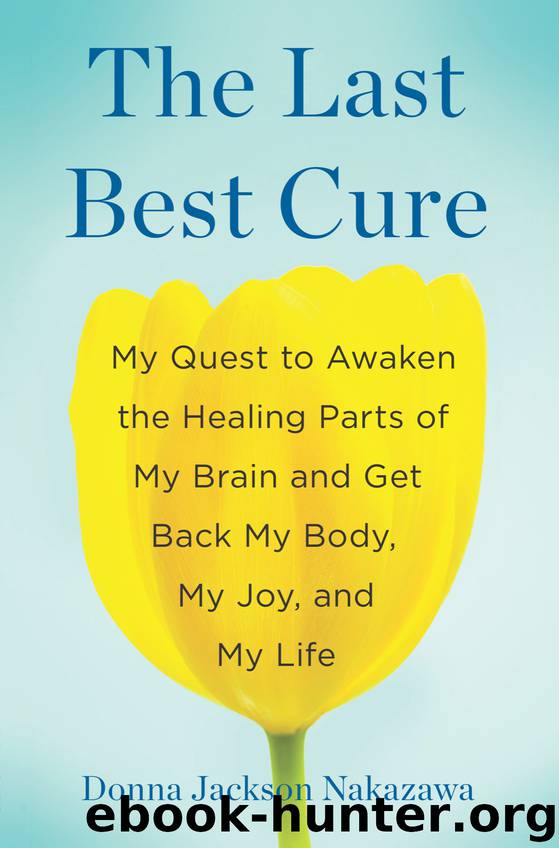The Last Best Cure by Donna Jackson Nakazawa

Author:Donna Jackson Nakazawa
Language: eng, jpn
Format: epub
Publisher: Penguin Publishing Group
Published: 2013-02-05T16:00:00+00:00
* * *
I RECALL READING The work of researchers at Cornell University, who recently discovered that during adolescence the brain actually employs mechanisms to suppress its most fearful memories and feelings. The brain literally blunts the synaptic activity in the amygdala, the fear center, dampening molecular signaling in the hippocampus, the brain region involved in retrieving fearful memories. Previously formed, traumatic emotional memories are pushed underground.
Think of it: our young brains sublimate the feelings that surround any early traumatic event so that we can get through the emotionally vulnerable coming-of-age years alive, grow up, and survive. Move into adulthood without, hopefully, throwing ourselves over the side of a bridge and removing ourselves from the gene pool.
Researchers say that our brain’s ability to black out our darkest recollections reveals a “unique form of brain plasticity” during the adolescent years.
Meanwhile, there is an analogous tenet from the field of psychology that holds that when we are young and experience trauma, the stressful emotions that accompany those memories become embedded deep in our bodies.
There is a story that psychologist Tara Brach tells that illustrates how these two ideas—that we suppress trauma even as our brain changes from it, and we store that trauma in our bodies—intertwine beautifully. A woman recalls being seven years old, and living with her alcoholic father who often beat her. Her mother does nothing to stop him. One night, after her father has attacked her again, the little girl hides in a closet, terrified. She’s crying, praying for help. When she opens her eyes she sees a magical fairy who whispers to her that although she can’t make all this pain disappear, she can help her to get through it and forget her pain, for now. “I am going to touch different parts of your body with my magic wand and they will change and be able to hold all the terrible feelings for you so that you can survive,” the fairy explains. She hides the little girl’s fear and rage in her belly. Another part of her pain she places in her neck. Another bit goes into her chest. One day, she tells the girl, when she is older, her body will begin to hurt. “You won’t be able to hold all this in, and your body will start unwinding its secrets.” But by then she will be grown and in a safer place so that she can look at the pain she’s hidden away. For now she will forget, but later she will remember, somewhere within, that there is a deep wound.
Until then, it is enough to get through what you must get through without thinking too much about it. And get through it alive.
This psychological precept makes sense from a physiological perspective: fight or flight causes our muscles and tendons to tense up. It takes energy to hold on to our pain—we clench our muscles to hold it in, or to hold off the thing we fear. These fight-or-flight stress hormones, over time, up the PIN response and fan inflammation.
Download
This site does not store any files on its server. We only index and link to content provided by other sites. Please contact the content providers to delete copyright contents if any and email us, we'll remove relevant links or contents immediately.
Hit Refresh by Satya Nadella(8854)
When Breath Becomes Air by Paul Kalanithi(8038)
The Girl Without a Voice by Casey Watson(7602)
A Court of Wings and Ruin by Sarah J. Maas(7252)
Do No Harm Stories of Life, Death and Brain Surgery by Henry Marsh(6683)
Shoe Dog by Phil Knight(4884)
Hunger by Roxane Gay(4677)
A Higher Loyalty: Truth, Lies, and Leadership by James Comey(4550)
The Rules Do Not Apply by Ariel Levy(4523)
Everything Happens for a Reason by Kate Bowler(4474)
Tuesdays with Morrie by Mitch Albom(4394)
The Immortal Life of Henrietta Lacks by Rebecca Skloot(4253)
How to Change Your Mind by Michael Pollan(4112)
Millionaire: The Philanderer, Gambler, and Duelist Who Invented Modern Finance by Janet Gleeson(4093)
All Creatures Great and Small by James Herriot(3984)
Tokyo Vice: An American Reporter on the Police Beat in Japan by Jake Adelstein(3860)
Elon Musk by Ashlee Vance(3854)
The Money Culture by Michael Lewis(3846)
Man and His Symbols by Carl Gustav Jung(3845)
